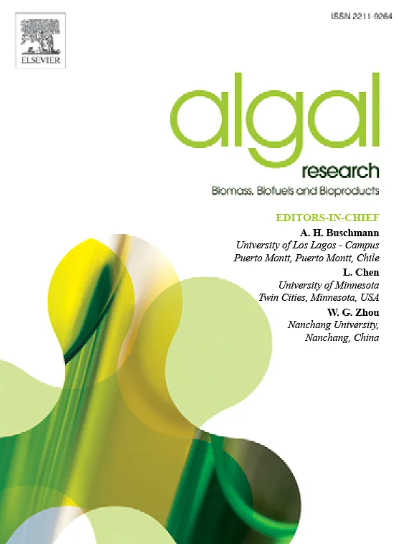Consequential life cycle assessment of pretreatment strategies for a microalgae-based wastewater treatment pilot unit in a circular livestock industry bioeconomy
IF 4.6
2区 生物学
Q1 BIOTECHNOLOGY & APPLIED MICROBIOLOGY
Algal Research-Biomass Biofuels and Bioproducts
Pub Date : 2025-04-15
DOI:10.1016/j.algal.2025.104041
引用次数: 0
Abstract
This study presents a Consequential Life Cycle Assessment (CLCA) of a microalgae-based wastewater treatment system for the livestock industry, integrated with a circular bioeconomy approach through biofertilizer production and biogas generation through anaerobic digestion (AD). Three treatment scenarios were evaluated, each employing different combinations of pretreatment technologies, including bioflocculation with chitosan. A scaled-up process model was developed using SuperPro Designer, and the environmental performance was assessed using SimaPro 9.7. Results indicate that scenario with a previous pretreatment using a centrifugation and UV radiation achieved the lowest global warming potential (8129 kg CO₂-eq per ton of dried microalgae), reduced fine particulate matter emissions (38.55 kg PM₂.₅-eq), and required less water consumption (114.29 m3) due to minimal chitosan usage compared to the other scenarios. Sensitivity analysis revealed significant variations in environmental impacts based on microalgae yield and biofertilizer application rates. A 20 % increase in biofertilizer application led to a 27.68 % additional reduction in global warming potential. This research provides compelling evidence for the environmental feasibility and economic viability of large-scale microalgae-based wastewater treatment systems, offering a promising pathway towards sustainable livestock practices and a circular bioeconomy within the agricultural sector.
循环畜牧业生物经济中基于微藻的废水处理中试装置预处理策略的后续生命周期评估
本研究提出了一种基于微藻的畜牧业废水处理系统的相应生命周期评估(CLCA),该系统通过生物肥料生产和厌氧消化(AD)产生沼气,与循环生物经济方法相结合。评估了三种处理方案,每种方案采用不同的预处理技术组合,包括壳聚糖生物絮凝。使用SuperPro Designer开发了一个放大的过程模型,并使用SimaPro 9.7对环境绩效进行了评估。结果表明,与其他方案相比,先前使用离心和紫外线辐射预处理的方案实现了最低的全球变暖潜势(每吨干燥微藻8129 kg CO₂-eq),减少了细颗粒物排放(38.55 kg PM₂.₅-eq),并且由于壳聚糖的使用最少,所需的用水量(114.29 m3)更少。敏感性分析显示,微藻产量和生物肥料施用量对环境的影响存在显著差异。生物肥料使用量每增加20%,全球变暖潜势就会额外降低27.68%。这项研究为大规模微藻废水处理系统的环境可行性和经济可行性提供了令人信服的证据,为农业部门实现可持续畜牧业和循环生物经济提供了一条有希望的途径。
本文章由计算机程序翻译,如有差异,请以英文原文为准。
求助全文
约1分钟内获得全文
求助全文
来源期刊

Algal Research-Biomass Biofuels and Bioproducts
BIOTECHNOLOGY & APPLIED MICROBIOLOGY-
CiteScore
9.40
自引率
7.80%
发文量
332
期刊介绍:
Algal Research is an international phycology journal covering all areas of emerging technologies in algae biology, biomass production, cultivation, harvesting, extraction, bioproducts, biorefinery, engineering, and econometrics. Algae is defined to include cyanobacteria, microalgae, and protists and symbionts of interest in biotechnology. The journal publishes original research and reviews for the following scope: algal biology, including but not exclusive to: phylogeny, biodiversity, molecular traits, metabolic regulation, and genetic engineering, algal cultivation, e.g. phototrophic systems, heterotrophic systems, and mixotrophic systems, algal harvesting and extraction systems, biotechnology to convert algal biomass and components into biofuels and bioproducts, e.g., nutraceuticals, pharmaceuticals, animal feed, plastics, etc. algal products and their economic assessment
 求助内容:
求助内容: 应助结果提醒方式:
应助结果提醒方式:


